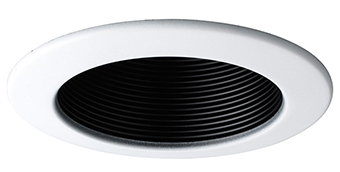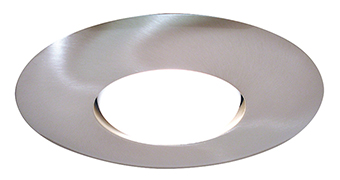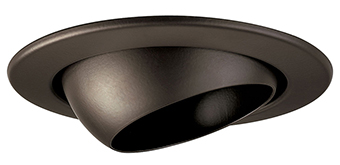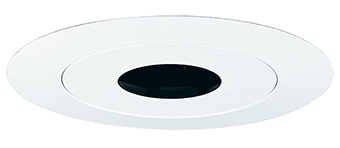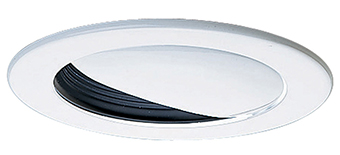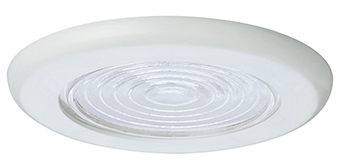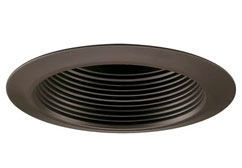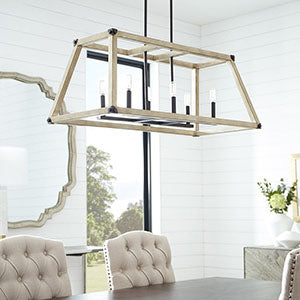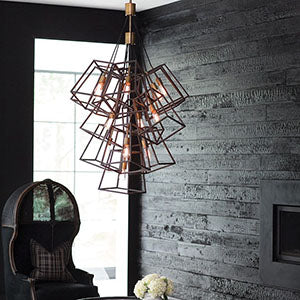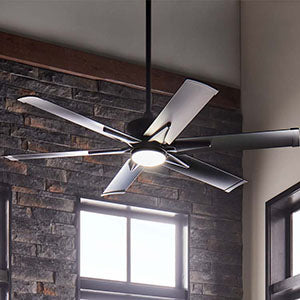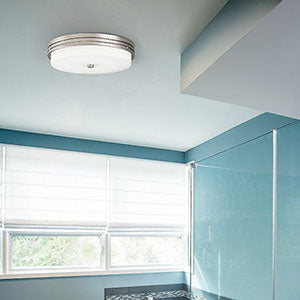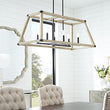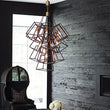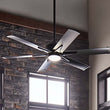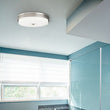Lighting
How To Choose Recessed Lighting
Recessed lighting fixtures can add a stylish and functional way to brighten up the rooms of your home. These sleek, hidden lighting fixtures are mounted flush with the ceilings, so they’re perfect for rooms with low ceilings or for spaces where you want a less obtrusive fixture. They can be used to provide general lighting, task lighting, or accent lighting within a room, making them a versatile fixture.

Recessed lighting fixtures are stylish, functional, and are flush mounted to blend in with the ceiling.
Before choosing and installing recessed lights, there are some things to consider. Do you need the light for an existing room or for an addition or a new construction house? Do you want to use the recessed lights as the primary light source for a whole room or just focused in a tighter space? What size, style, and color fixture do you want to suit the rest of your décor? What type of recessed lighting bulbs do you want to use? Here’s some helpful tips to help you make the right choice when selecting your recessed lighting fixtures.
Parts of the Recessed Light
Also called can lights, pot lights, or downlights, recessed lights have three main components that define the fixture’s type: housing, trim style, and bulb (lamp) type.
Housings
The housing is the actual framework of the fixture. It is installed above the ceiling and holds the trim and light bulb. There are different types of housing styles to suit certain needs.

A new construction housing is designed for installation where you have access above the ceiling.
- A New Construction housing is required in new homes or in rooms that are being added to your home. They are mounted directly to the ceiling joists before the ceiling is installed and require you have access above the ceiling to run the wiring.
- A Remodel housing is designed to allow installation of a recessed light in an existing ceiling where you can’t access above the ceiling to run wiring. They are supported by pushing metal clips through the housing onto the top of the ceiling drywall or plaster.
- An Insulation-Compatible (IC) housing is designed for use in locations where it comes into direct contact with insulation. These housings help prevent the heat build-up caused by the insulation from causing a fire or hampering the efficiency of the light.
- Non-IC housings must have at least 3 inches of clearance from insulation and can be used in applications where there’s no insulation between the ceiling and the floor above it.
- Airtight (AT) housings help prevent heat loss during cold months. If your lighting fixture isn’t AT rated, installing it can create a chimney that allows your home’s heat to escape though especially if there is not a living space above it such as in the attic.
Trims
The trim fits inside the housing and extends out to form the outer ring that is in view when you look up at the ceiling. It gives the fixture its style along with providing function based on its design. Common types are:
Baffle trim – has a ribbed interior to minimize glare. The bulb fits up side the trim and is not flush with the ceiling. Black baffles reduce the most glare while white baffles reduce the appearance of the holes in the ceiling.
Reflector trim – has smooth, polished interior surface to reflect more light. The bulb is inset within the trim the same as with a baffle design. Some fixtures come with a tinted surface.
Open trim – allows the bulb to fit flush or nearly flush with the ceiling and offers unrestricted illumination.
Eyeball trim – features a pivoting design that allows you to direct the light where you want it. It can also function as wall-wash or accent lighting.
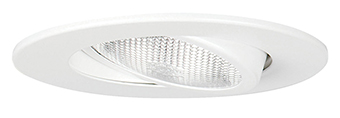
Gimbal trim – functions like eyeball trim in that it allows directional adjustment, but the lamp does not extend as far below the ceiling. It will block some of the light when fully pivoted.
Pin hole trim – features a smaller opening to narrow the light to a tightly focused beam.
Wall-wash trim – features a shield over half the opening to restrict the light to a specific area. Commonly used over fireplaces or artwork to highlight a feature.
Shower trim – usually has a tempered glass lens and is wet-rated for use within a shower stall.
Trims also come in a variety of finishes you can match to your décor. The most common colors include white, black, nickel, chrome, bronze, and silver. Usually found in round shapes, trim rings also come in square shapes and different sizes including 3-inch, 4-inch, and 6-inch diameters. You can easily replace the trim piece for a different color or style when you update your room or change your décor. White recessed lighting trim is the most popular color since it blends in with the ceiling to make the light fixture less noticeable.
Light bulbs
The last component of the fixture is the light bulb or lamp it uses to provide the illumination. When selecting recessed light, pay attention to the type and size of bulb or lamp the fixture requires. Some recessed lights use screw-in bulbs while others work with pin-based bulbs.
Also, never exceed the maximum wattage recommended for your light fixture for safety. Read the inside of the housing to determine what wattage and bulb type to use for your particular fixture.
Types of Recessed Lighting Kits
Many recessed lighting fixtures are sold with the housing and trim in one convenient package or kit. Kits are available for many sizes and types of recessed lighting. The most common types of kits are:
- Line-voltage kits are the standard light kit. They run on household current.
- Low-voltage kits use a transformer to reduce household voltage and help with energy costs, but are more expensive. Some kits will have a built-in transformer, while others require that you purchase a transformer separately.
- LED retrofit kits let you convert your incandescent recessed lights to more cost-efficient LED and are easy to install into existing housings.
Other Recessed Lighting Factors to Consider
Size and component compatibility
Recessed lights typically come in sizes ranging from 3 to 6 inches in diameter. The size you need will depend on the planned function, location of the light, and the overall room size.
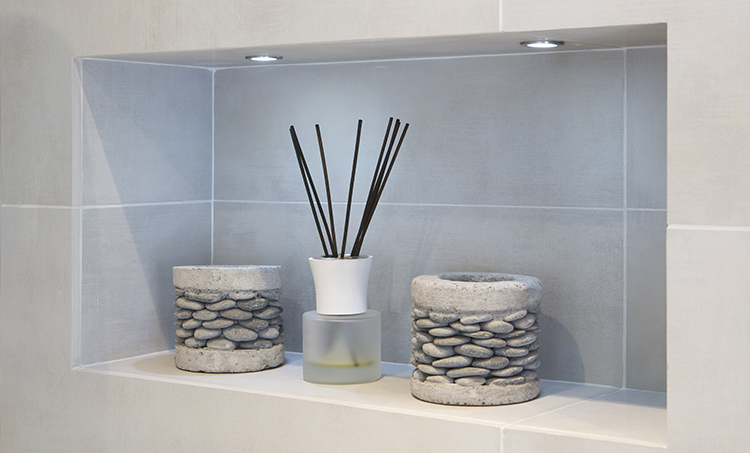
Add small recessed lights to highlight specific areas for a modern touch.
Small recessed lights are good for use as accent or task lighting and also work well for highlighting specific areas or architectural features. They tend to look better with modern décor styles and proportionally smaller spaces.
Larger lights work best for general room lighting and look great with more traditional style décor. Keep in mind your ceiling height. The higher the ceiling, the wider and more diffuse will be the light that is cast.
Also, pay attention to compatibility between trim and housing components, especially if you are retrofitting or updating older and existing fixtures. Trim and housings may be the same size, but may not always work together. Even trims and housings made by the same manufacturer may not be compatible. Always make sure that the components you choose are designed to function together.
Choose your bulb type
Any recessed lighting fixtures that has a medium screw-based lamp holder can take an incandescent, fluorescent, halogen, or even LED light bulb with a medium base. Some fixtures come equipped with special lamp holders, or sockets, that can only take certain types of light bulbs, usually fluorescent or halogen. Choose which style best suits your needs depending on the type of bulb you prefer and how or where the fixture will be used.
The quality of the light in a room will be affect by factors such as color temperature, lumens, and wattage. Many recessed lighting fixtures use Halogen and LED since they are more energy-efficient. LED bulbs are cool to the touch and long-lasting. Typically, you will get the best results with a warm white color temperature for living rooms and bedrooms, a bright white color temperature for kitchens and workspaces, and a daylight color temperature for home offices and reading nooks.
If you like the savings, long-life, and cooler temperature of fluorescent lamps, but also like the warmer color of an incandescent light, you can buy fluorescent lamps with a high Kelvin value. If you want or need a high-intensity light to illuminate a small area, halogen might be your best choice. For warm, general lighting applications, most people prefer incandescent lamps.
To dim or not to dim?
If you want to be able to dim your recessed lights, or control them with a remote or automated smart home system, you will need fixtures that use incandescent, halogen, or LED light bulbs. Fluorescent light bulbs are not dimmable unless they have a dimmable ballast.
Installation
Compared to the previous generation recessed lighting systems, today’s fixtures are easier to install and are available with options designed to meet almost every need. They are more energy efficient and performing to higher standards then the models of yesterday.
Experienced DIYers can update or retrofit existing fixtures. However, if you are planning on installing new systems, you’ll need to have a licensed contractor or electrician who is familiar with residential lighting to help you with a lighting plan, ensure your lights are meeting any local codes, and install the fixtures for you.

